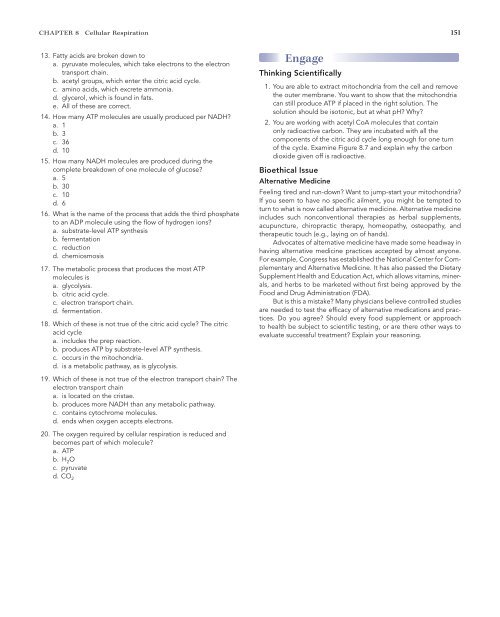Cellular Respiration
Cellular Respiration
Cellular Respiration
Create successful ePaper yourself
Turn your PDF publications into a flip-book with our unique Google optimized e-Paper software.
CHAPTER 8 <strong>Cellular</strong> <strong>Respiration</strong> 151<br />
13. Fatty acids are broken down to<br />
a. pyruvate molecules, which take electrons to the electron<br />
transport chain.<br />
b. acetyl groups, which enter the citric acid cycle.<br />
c. amino acids, which excrete ammonia.<br />
d. glycerol, which is found in fats.<br />
e. All of these are correct.<br />
14. How many ATP molecules are usually produced per NADH?<br />
a. 1<br />
b. 3<br />
c. 36<br />
d. 10<br />
15. How many NADH molecules are produced during the<br />
complete breakdown of one molecule of glucose?<br />
a. 5<br />
b. 30<br />
c. 10<br />
d. 6<br />
16. What is the name of the process that adds the third phosphate<br />
to an ADP molecule using the flow of hydrogen ions?<br />
a. substrate-level ATP synthesis<br />
b. fermentation<br />
c. reduction<br />
d. chemiosmosis<br />
17. The metabolic process that produces the most ATP<br />
molecules is<br />
a. glycolysis.<br />
b. citric acid cycle.<br />
c. electron transport chain.<br />
d. fermentation.<br />
18. Which of these is not true of the citric acid cycle? The citric<br />
acid cycle<br />
a. includes the prep reaction.<br />
b. produces ATP by substrate-level ATP synthesis.<br />
c. occurs in the mitochondria.<br />
d. is a metabolic pathway, as is glycolysis.<br />
19. Which of these is not true of the electron transport chain? The<br />
electron transport chain<br />
a. is located on the cristae.<br />
b. produces more NADH than any metabolic pathway.<br />
c. contains cytochrome molecules.<br />
d. ends when oxygen accepts electrons.<br />
20. The oxygen required by cellular respiration is reduced and<br />
becomes part of which molecule?<br />
a. ATP<br />
b. H 2O<br />
c. pyruvate<br />
d. CO 2<br />
Engage<br />
Thinking Scientifically<br />
1. You are able to extract mitochondria from the cell and remove<br />
the outer membrane. You want to show that the mitochondria<br />
can still produce ATP if placed in the right solution. The<br />
solution should be isotonic, but at what pH? Why?<br />
2. You are working with acetyl CoA molecules that contain<br />
only radioactive carbon. They are incubated with all the<br />
components of the citric acid cycle long enough for one turn<br />
of the cycle. Examine Figure 8.7 and explain why the carbon<br />
dioxide given off is radioactive.<br />
Bioethical Issue<br />
Alternative Medicine<br />
Feeling tired and run-down? Want to jump-start your mitochondria?<br />
If you seem to have no specific ailment, you might be tempted to<br />
turn to what is now called alternative medicine. Alternative medicine<br />
includes such nonconventional therapies as herbal supplements,<br />
acupuncture, chiropractic therapy, homeopathy, osteopathy, and<br />
therapeutic touch (e.g., laying on of hands).<br />
Advocates of alternative medicine have made some headway in<br />
having alternative medicine practices accepted by almost anyone.<br />
For example, Congress has established the National Center for Complementary<br />
and Alternative Medicine. It has also passed the Dietary<br />
Supplement Health and Education Act, which allows vitamins, minerals,<br />
and herbs to be marketed without first being approved by the<br />
Food and Drug Administration (FDA).<br />
But is this a mistake? Many physicians believe controlled studies<br />
are needed to test the efficacy of alternative medications and practices.<br />
Do you agree? Should every food supplement or approach<br />
to health be subject to scientific testing, or are there other ways to<br />
evaluate successful treatment? Explain your reasoning.

















